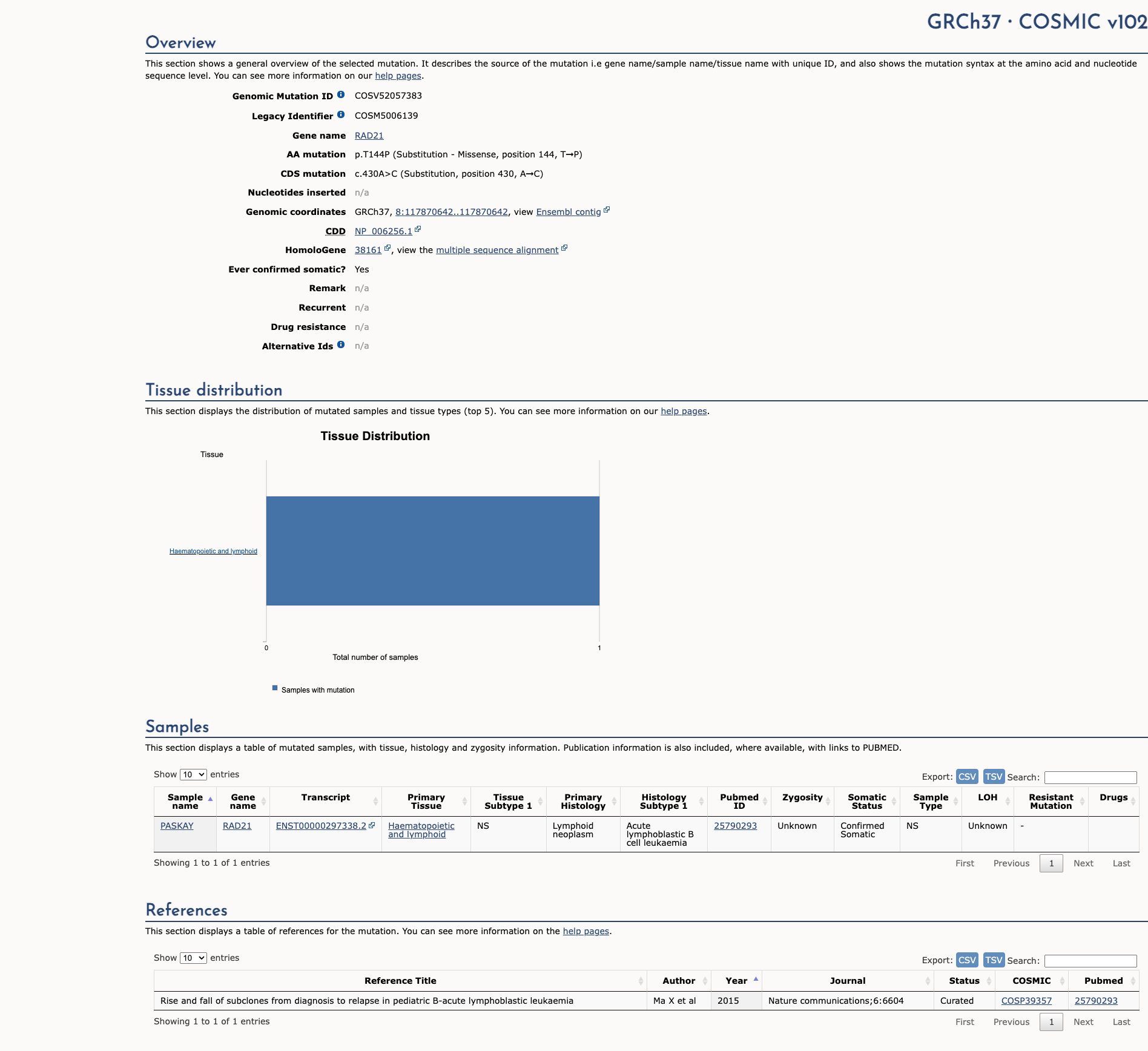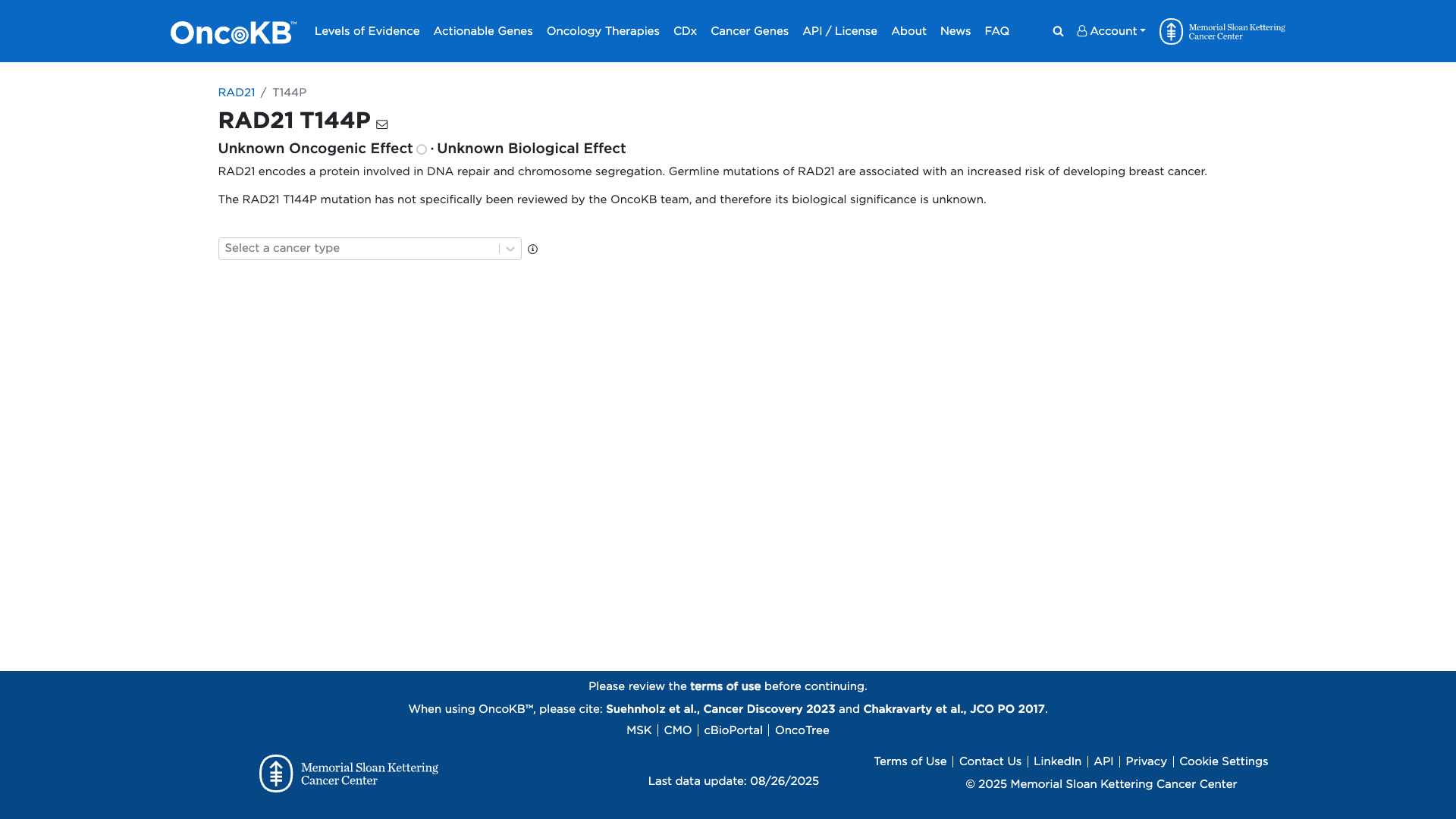RAD21 c.430A>C, p.Thr144Pro
NM_006265.2:c.430A>C
COSMIC ID: COSM5006139
Variant of Uncertain Significance (VUS)
RAD21 p.T144P is a missense change absent from population databases (PM2) with computational data favoring benign (BP4). No functional, segregation, or clinical correlation data are available to support pathogenic or benign classification. The variant remains a Variant of Uncertain Significance.
ACMG/AMP Criteria Applied
PM2
BP4
Genetic Information
Gene & Transcript Details
Gene
RAD21
Transcript
NM_006265.3
MANE Select
Total Exons
14
Strand
Reverse (−)
Reference Sequence
NC_000008.10
Alternative Transcripts
| ID | Status | Details |
|---|---|---|
| NM_006265.2 | RefSeq Select | 14 exons | Reverse |
| NM_006265.1 | Alternative | 14 exons | Reverse |
Variant Details
HGVS Notation
NM_006265.2:c.430A>C
Protein Change
T144P
Location
Exon 5
(Exon 5 of 14)
5'Exon Structure (14 total)3'
Functional Consequence
Loss of Function
Related Variants
No evidence of other pathogenic variants at position 144 in gene RAD21
Alternate Identifiers
COSM5006139
Variant interpretation based on transcript NM_006265.3
Genome Browser
Loading genome browser...
HGVS InputNM_006265:c.430A>C
Active Tracks
ConservationRefSeqClinVargnomAD
Navigation tips: Use mouse to drag and zoom. Click on features for details.
Clinical Data
Population Frequency
Global Frequency
0.0 in 100,000
Extremely Rare
Global: 0.0%
0%
0.05%
0.1%
1%
5%
10%+
ACMG Criteria Applied
PM2
This variant is not present in gnomAD (PM2 criteria applies).
Classification
Unknown
Publications (0)
No publication details.
Clinical Statement
Functional Impact
Functional Domain
Hotspot Status
Not a hotspot
Domain Summary
This variant is not located in a mutational hotspot or critical domain (0 mutations).
Related Variants in This Domain
No evidence of other pathogenic variants at position 144 in gene RAD21
Computational Analysis
Pathogenicity Predictions
REVEL Score
0.668
0.668
Likely Benign0.0
Uncertain (Low)0.2
Uncertain (Med)0.5
Likely Pathogenic0.75
REVEL scores ≥ 0.75 are strong evidence (PP3)
Predictor Consensus
Mixed/VUS
PP3 Applied
No
Additional Predictors
Pathogenic:
polyphen_prediction: probably_damagingprimateai: D
Benign:
CADD: 5.24metasvm: Tmetalr: T
Neutral: Show all
VCEP Guidelines
Applied ACMG/AMP Criteria (VCEP Specific)
PVS1
PVS1 (Not Applied) Strength Modified
According to standard ACMG guidelines, the rule for PVS1 is: "Null variant (nonsense, frameshift, canonical ±1 or 2 splice sites, initiation codon, single or multi-exon deletion) in a gene where loss of function is a known mechanism of disease." The evidence for this variant shows: NM_006265.2:c.430A>C (p.T144P) is a missense change, not a null variant. Therefore, this criterion is not applied because the variant is not predicted to result in loss of function.
PS1
PS1 (Not Applied) Strength Modified
According to standard ACMG guidelines, the rule for PS1 is: "Same amino acid change as a previously established pathogenic variant regardless of nucleotide change." The evidence for this variant shows: there is no known pathogenic variant reporting the same p.T144P change in RAD21. Therefore, this criterion is not applied because no matching pathogenic amino acid change has been reported.
PS2
PS2 (Not Applied) Strength Modified
According to standard ACMG guidelines, the rule for PS2 is: "De novo (both maternity and paternity confirmed) in a patient with the disease and no family history." The evidence for this variant shows: no data on parental testing or de novo status. Therefore, this criterion is not applied due to lack of de novo evidence.
PS3
PS3 (Not Applied) Strength Modified
According to standard ACMG guidelines, the rule for PS3 is: "Well-established functional studies supportive of a damaging effect on the gene or gene product." The evidence for this variant shows: no functional assays or studies have been performed for RAD21 p.T144P. Therefore, this criterion is not applied because functional data are missing.
PS4
PS4 (Not Applied) Strength Modified
According to standard ACMG guidelines, the rule for PS4 is: "Prevalence in affected individuals is significantly increased compared with controls." The evidence for this variant shows: no case-control or cohort data are available. Therefore, this criterion is not applied due to absence of case prevalence data.
PM1
PM1 (Not Applied) Strength Modified
According to standard ACMG guidelines, the rule for PM1 is: "Located in a mutational hot spot and/or a well-established functional domain without benign variation." The evidence for this variant shows: no information on RAD21 domain location or hotspot at residue T144. Therefore, this criterion is not applied due to lack of domain/hotspot annotation.
PM2
PM2 (Moderate)
According to standard ACMG guidelines, the rule for PM2 is: "Absent from controls (or at extremely low frequency if recessive) in Exome Sequencing Project, 1000 Genomes Project, or Exome Aggregation Consortium." The evidence for this variant shows: not found in gnomAD or other population databases (MAF = 0%). Therefore, this criterion is applied at Moderate strength because the variant is absent from population controls.
PM3
PM3 (Not Applied) Strength Modified
According to standard ACMG guidelines, the rule for PM3 is: "Detected in trans with a pathogenic variant for recessive disorders." The evidence for this variant shows: no information on phasing or second allele. Therefore, this criterion is not applied due to missing trans-allele data.
PM4
PM4 (Not Applied) Strength Modified
According to standard ACMG guidelines, the rule for PM4 is: "Protein length changes due to in-frame deletions/insertions or stop-loss variants." The evidence for this variant shows: p.T144P is a missense substitution without change in protein length. Therefore, this criterion is not applied because the protein length is unchanged.
PM5
PM5 (Not Applied) Strength Modified
According to standard ACMG guidelines, the rule for PM5 is: "Novel missense change at an amino acid residue where a different pathogenic missense change has been seen before." The evidence for this variant shows: no other pathogenic missense variants reported at residue T144. Therefore, this criterion is not applied due to absence of prior pathogenic missense at this position.
PM6
PM6 (Not Applied) Strength Modified
According to standard ACMG guidelines, the rule for PM6 is: "Assumed de novo, but without confirmation of paternity and maternity." The evidence for this variant shows: no data on parental origin. Therefore, this criterion is not applied due to lack of de novo assumption data.
PP1
PP1 (Not Applied) Strength Modified
According to standard ACMG guidelines, the rule for PP1 is: "Co-segregation with disease in multiple affected family members." The evidence for this variant shows: no family segregation information. Therefore, this criterion is not applied due to missing segregation data.
PP2
PP2 (Not Applied) Strength Modified
According to standard ACMG guidelines, the rule for PP2 is: "Missense variant in a gene with a low rate of benign missense variation and where missense variants are a common mechanism of disease." The evidence for this variant shows: no gene-specific constraint or missense tolerance data provided for RAD21. Therefore, this criterion is not applied due to lack of gene-level missense variation data.
PP3
PP3 (Not Applied) Strength Modified
According to standard ACMG guidelines, the rule for PP3 is: "Multiple lines of computational evidence support a deleterious effect on the gene or gene product." The evidence for this variant shows: in silico predictions are mixed (PolyPhen probably damaging, CADD low score, SpliceAI no splicing impact). Overall computational evidence does not consistently support deleteriousness. Therefore, this criterion is not applied.
PP4
PP4 (Not Applied) Strength Modified
According to standard ACMG guidelines, the rule for PP4 is: "Patient’s phenotype or family history highly specific for a disease with a single genetic etiology." The evidence for this variant shows: no phenotype or clinical presentation data provided. Therefore, this criterion is not applied due to missing phenotype information.
PP5
PP5 (Not Applied) Strength Modified
According to standard ACMG guidelines, the rule for PP5 is: "Reputable source reports variant as pathogenic, but without accessible evidence." The evidence for this variant shows: no external assertions or database entries reporting pathogenicity. Therefore, this criterion is not applied due to absence of reputable source reports.
BA1
BA1 (Not Applied) Strength Modified
According to standard ACMG guidelines, the rule for BA1 is: "Allele frequency is greater than 5% in population databases." The evidence for this variant shows: MAF = 0% in gnomAD. Therefore, this criterion is not applied.
BS1
BS1 (Not Applied) Strength Modified
According to standard ACMG guidelines, the rule for BS1 is: "Allele frequency is greater than expected for disorder." The evidence for this variant shows: not present in population databases. Therefore, this criterion is not applied.
BS2
BS2 (Not Applied) Strength Modified
According to standard ACMG guidelines, the rule for BS2 is: "Observed in a healthy adult individual for a dominant disorder with full penetrance expected at an early age." The evidence for this variant shows: no reports of observation in healthy individuals. Therefore, this criterion is not applied due to missing healthy individual data.
BS3
BS3 (Not Applied) Strength Modified
According to standard ACMG guidelines, the rule for BS3 is: "Well-established functional studies show no damaging effect on protein function or splicing." The evidence for this variant shows: no functional studies performed. Therefore, this criterion is not applied because functional evidence is lacking.
BS4
BS4 (Not Applied) Strength Modified
According to standard ACMG guidelines, the rule for BS4 is: "Lack of segregation in affected family members." The evidence for this variant shows: no family segregation data. Therefore, this criterion is not applied due to missing segregation analysis.
BP1
BP1 (Not Applied) Strength Modified
According to standard ACMG guidelines, the rule for BP1 is: "Missense variant in a gene where only loss of function causes disease." The evidence for this variant shows: RAD21 has reports of pathogenic missense variants. Therefore, this criterion is not applied because missense is a known mechanism for RAD21 disease.
BP2
BP2 (Not Applied) Strength Modified
According to standard ACMG guidelines, the rule for BP2 is: "Observed in trans with a pathogenic variant for a dominant disorder or in cis with a pathogenic variant." The evidence for this variant shows: no phasing or co-occurrence data. Therefore, this criterion is not applied.
BP3
BP3 (Not Applied) Strength Modified
According to standard ACMG guidelines, the rule for BP3 is: "In-frame deletions/insertions in a repetitive region without known function." The evidence for this variant shows: p.T144P is a missense variant, not an in-frame indel. Therefore, this criterion is not applied.
BP4
BP4 (Supporting)
According to standard ACMG guidelines, the rule for BP4 is: "Multiple lines of computational evidence suggest no impact on gene or gene product." The evidence for this variant shows: mixed in silico results with SpliceAI predicting no splicing impact and overall leaning toward benign (low CADD, benign MetaSVM/MetaLR). Therefore, this criterion is applied at Supporting strength because computational data do not support a deleterious effect.
BP5
BP5 (Not Applied) Strength Modified
According to standard ACMG guidelines, the rule for BP5 is: "Variant found in a case with an alternate molecular basis for disease." The evidence for this variant shows: no case reports with alternative molecular findings. Therefore, this criterion is not applied.
BP6
BP6 (Not Applied) Strength Modified
According to standard ACMG guidelines, the rule for BP6 is: "Reputable source reports variant as benign, but without accessible evidence." The evidence for this variant shows: no external benign assertions. Therefore, this criterion is not applied.
BP7
BP7 (Not Applied) Strength Modified
According to standard ACMG guidelines, the rule for BP7 is: "Synonymous variant with no predicted impact on splicing." The evidence for this variant shows: it is a missense substitution, not synonymous. Therefore, this criterion is not applied.



